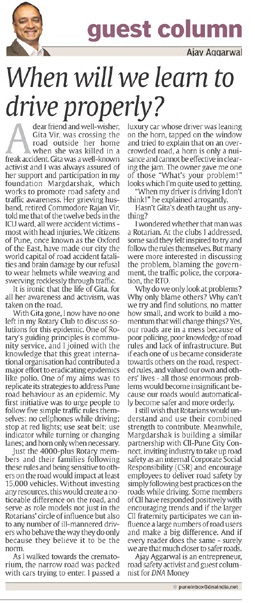 A dear friend and well-wisher, Gita Vir, was crossing the road outside her home when she was killed in a freak accident. Gita was a well-known activist and I was always assured of her support and participation in my foundation Margdarshak, which works to promote road safety and traffic awareness. Her grieving husband, retired Commodore Rajan Vir, told me that of the twelve beds in the ICU ward, all were accident victims – most with head injuries. We citizens of Pune, once known as the Oxford of the East, have made our city the world capital of road accident fatalities and brain damage by our refusal to wear helmets while weaving and swerving recklessly through traffic.
A dear friend and well-wisher, Gita Vir, was crossing the road outside her home when she was killed in a freak accident. Gita was a well-known activist and I was always assured of her support and participation in my foundation Margdarshak, which works to promote road safety and traffic awareness. Her grieving husband, retired Commodore Rajan Vir, told me that of the twelve beds in the ICU ward, all were accident victims – most with head injuries. We citizens of Pune, once known as the Oxford of the East, have made our city the world capital of road accident fatalities and brain damage by our refusal to wear helmets while weaving and swerving recklessly through traffic.
It is ironic that the life of Gita, for all her awareness and activism, was taken on the road.
With Gita gone, I now have no one left in my Rotary Club to discuss solutions for this epidemic. One of Rotary’s guiding principles is community service, and I joined with the knowledge that this great international organisation had contributed a major effort to eradicating epidemics like polio. One of my aims was to replicate its strategies to address Pune road behaviour as an epidemic. My first initiative was to urge people to follow five simple traffic rules themselves: no cellphones while driving; stop at red lights; use seat belt; use indicator while turning or changing lanes; and horn only when necessary.
Just the 4000-plus Rotary members and their families following these rules and being sensitive to others on the road would impact at least 15,000 vehicles. Without investing any resources, this would create a noticeable difference on the road, and serve as role models not just in the Rotarians’ circle of influence but also to any number of ill-mannered drivers who behave the way they do only because they believe it to be the norm.
As I walked towards the crematorium, the narrow road was packed with cars trying to enter. I passed a luxury car whose driver was leaning on the horn, tapped on the window and tried to explain that on an overcrowded road, a horn is only a nuisance and cannot be effective in clearing the jam. The owner gave me one of those “What’s your problem!” looks which I’m quite used to getting.
“When my driver is driving I don’t think!” he explained arrogantly.
Hasn’t Gita’s death taught us anything?
I wondered whether that man was a Rotarian. At the clubs I addressed, some said they felt inspired to try and follow the rules themselves. But many were more interested in discussing the problem, blaming the government, the traffic police, the corporation, the RTO.
Why do we only look at problems? Why only blame others? Why can’t we try and find solutions, no matter how small, and work to build a momentum that will change things? Yes, our roads are in a mess because of poor policing, poor knowledge of road rules and lack of infrastructure. But if each one of us became considerate towards others on the road, respected rules, and valued our own and others’ lives – all those enormous problems would become insignificant because our roads would automatically become safer and more orderly.
I still wish that Rotarians would understand and use their combined strength to contribute. Meanwhile, Margdarshak is building a similar partnership with CII-Pune City Connect, inviting industry to take up road safety as an internal Corporate Social Responsibility (CSR) and encourage employees to deliver road safety by simply following best practices on the roads while driving. Some members of CII have responded positively with encouraging trends and if the larger CII fraternity participates we can influence a large numbers of road users and make a big difference. And if every reader does the same – surely we are that much closer to safer roads.
A special editorial for DNA Pune dated 25 April 2012.

You must be logged in to post a comment.